Picturing Russia’s Men: Masculinity and Modernity in Nineteenth-Century Painting by Allison Leigh
Reviewed by Lucien MidavaineLucien Midavaine
Independent scholar
Email the author: Lucien.Midavaine[at]gmail.com
Citation: Lucien Midavaine, book review of Picturing Russia’s Men: Masculinity and Modernity in Nineteenth-Century Painting by Allison Leigh, Nineteenth-Century Art Worldwide 22, no. 2 (Autumn 2023), https://doi.org/10.29411/ncaw.2023.22.2.10.
This work is licensed under a Creative Commons Attribution-NonCommercial 4.0 International License  unless otherwise noted.
unless otherwise noted.
Your browser will either open the file, download it to a folder, or display a dialog with options.
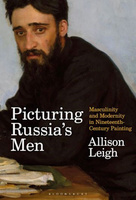
Allison Leigh,
Picturing Russia’s Men: Masculinity and Modernity in Nineteenth-Century Painting.
London: Bloomsbury Visual Arts, 2020.
296 pp.; 16 color and 60 b&w illus.; bibliography; notes; index.
$35 (paperback)
ISBN: 9781501341793
With Picturing Russia’s Men, Allison Leigh takes the reader through six prolific decades of Russian art. She proposes a new understanding of masculinity in Imperial Russia, from the 1820s to the 1880s, by focusing specifically on five of its most renowned painters. Leigh’s work is remarkable in the way it embeds five stories—regularly touching on the intimate life of the men she discusses—in a socio-historical context that is precisely defined and easy to grasp. Thanks to this approach and to Leigh’s fluid writing, Picturing Russia’s Men is an illuminating and approachable book, even for readers unfamiliar with Russian art and history.
Referencing sociologist David Morgan, the author pleads for the importance of her topic in the book’s introduction, arguing that “women are obscured from our vision by being placed consistently in the background, while men are obscured by being pushed too much into the foreground. . . . Such elevation of male behavior to the level of history actually tells us very little about men’s real feelings, skills, knowledge, or capabilities” (12). Certainly, this is the most interesting ambition of the book: attempting to perceive and understand men’s intimate feelings and struggles that result from normative social assertions regarding their gender.
The author is part of a biographical and socio-historical approach that combines the visual analysis of artworks (often portraits) with biographical data (often from letters). Leigh’s perspective also gives an important place to the political context, a key element in understanding the period’s model of masculinity. Indeed, the patriarchal culture of Imperial Russia was deeply tied to the tsarist regime, as the author explains in her introduction. Autocracy ran through all of society, from the state to the private sphere. Male dominance (in the roles of husband or father) was seen as an echo of the tsar’s authority over his people, and the state actively supported patriarchal authority. In this respect, it is understandable why the author focuses on a period corresponding to the reign of two tsars: Nicolas I (1825–55) and Alexander II (1855–81).
To address a subject as vast and complex as masculinity, Leigh decides to focus primarily on paintings, and more specifically on how “painterly representations reflected, violated, or sometimes even produced [gender norms] in Russian culture over the course of the nineteenth century” (8). The author clearly delimits her theoretical framework by relying on the definition of masculinity as “a set of normative assertions about the nature of the adult male and his conduct in society” (8). Proceeding chronologically, each chapter examines the fundamental principles of masculinity relevant to the historical time being examined. Because it focuses on five male artists, however, the book is often able to discuss the masculinity of these specific individuals.
Her starting point is the 1826 opening of a gallery of military portraits in St. Petersburg. The gallery is a prime example of the model of masculinity established in the early nineteenth century; it displays two hundred portraits of men who fought against Napoleon’s army in 1812–14. Historians have established that the victory over the French invader started a new era in the Russian Empire. The victory ignited a sense of pride and a renewed confidence that before Russia lay a new future, different from its past and present. However, Leigh also analyzes how the victory over Napoleon introduced a new model of masculinity. Promoting strong gender values became a defining strategy at state-supported organizations during the reign of Alexander I (1801–25). The idea of masculinity which was developed at the time encompassed physical energy and bravery, loyalty to the autocracy, charming social manners, and a sharp awareness of elegant demeanor. Naturally, most men did not satisfy all these conditions, which often led to either suffering from inability to conform to these standards or to the establishment of alternative masculinities.
The first two chapters of the book focus on Karl Bryullov (1799–1852) and Pavel Fedotov (1815–52). In this first part, titled “Autocratic Masculinity,” Leigh discusses the harsh training of young artists in early nineteenth-century Russia. She clearly explains how art education was modeled on military training. It was a way to turn boys into ideal citizens, conscious of their duties. Regarding Bryullov, the author discusses his role as a man and as a son. He was one of the most celebrated artists in Russia during his lifetime. Even though a successful career was a criterion of an accomplished masculinity, Bryullov failed to fulfill other expectations: he was never a husband, and he never fathered a child. However, Leigh argues that he compensated for not meeting these gendered expectations by adopting a paternal role for his students as a respected mentor, thereby establishing his masculinity in a work context.
The second chapter also tackles the connections between art and the military, as Fedotov’s career was marked by a constant search for a balance between his duties as an officer and his artistic practice. This chapter looks at Fedotov’s drawings and paintings, mostly of his fellow officers. The author points out the way in which his unidealized depictions divert from the portrait gallery discussed in the introduction; Fedotov moves towards stronger realism by not emphasizing any masculine status. As with Bryullov, the author attempts to determine the extent to which Fedotov fulfilled the ideal masculine characteristics of the time. The author looks at how making art influenced the way Fedotov established a masculine identity. She argues that the failure to fulfill masculine expectations—wife, children, financial stability—played a central role in his deteriorating mental health at the end of his life, until his death at only thirty-seven.
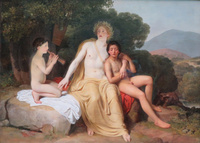
The second part, about “Homosociality and Homoeroticism,” contains two chapters, one on Alexander Ivanov (1806–58), and the other on the Artel of Artists, a cooperative association established in 1863. Looking at the elaboration of Ivanov’s unfinished canvas Apollo, Hyacinthus, and Cypress (fig. 1) and at drawings he produced as a student, this chapter examines how Ivanov’s artworks might uncover his (homo)sexuality. This richly illustrated chapter illuminates the exceptional finesse of Ivanov’s rendering of male bodies. Leigh argues that the homoeroticism in his oeuvre was a personal space that he devoted to his own enjoyment. This chapter further explores the extent to which homoeroticism was accepted. Since the mid-eighteenth century, the eroticized ephebic male body had been part of the classical art canon. Therefore, the border was thin between acceptable homoerotic depictions and those that could subvert the dominant gender paradigms during the severe rule of Nicholas I.
The fourth chapter stands out as the only one not devoted to one artist, but to a group. The Artel of Artists was a cooperative association of fourteen (male) artists who withdrew from the gold medal competition of the Academy of Arts in St. Petersburg after the Academy Council refused to let them select freely the subject of paintings they could submit. This rebellious act—led by painter Ivan Kramskoi (1837–87)—gave birth to a brotherhood. Leigh analyzes the solidarity and close bonds between men, as well as their unrealized homosocial ambitions.
Exploring more of Kramskoi’s life and career, the third and final part, titled “Modern Women and Their Wounded Men,” sheds light on his difficult financial situation and his portrayals of women. Excerpts from his letters to his wife reveal his doubts, flaws, and touching vulnerability. At the same time, his portraits of women, mainly of his wife and daughter, show a man concerned about the roles imposed on women in the society of his time, a concern which was compounded when his daughter herself began to pursue a career as a painter. This alternative and “wounded” masculinity is also the subject of the last chapter, centered on Ilya Repin (1844–1930). This chapter summarizes the genesis of Repin’s masterpiece Ivan the Terrible and His Son Ivan (fig. 2). Painted following the bloody assassination of Alexander II in 1881, Repin depicts Tsar Ivan stripped of all his patriarchal dignity, embracing the body of his son whom he has just killed in a fit of anger. With this work, Repin decides to show not the heroism of great men but rather broken men, victims of ideals of power and violence. This idea of broken men appears even more strongly in his portraits, notably those of the writer Vsevolod Garshin (fig. 3) and the composer Modest Mussorgsky (fig. 4). After five chapters dealing with the rigidity of Russian patriarchy, the transgression in the portrayal of masculinity in Repin’s portraits of men struggling with mental health becomes starkly apparent, even to an eye unfamiliar with nineteenth-century painting.
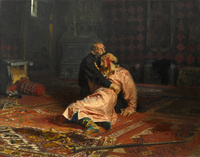
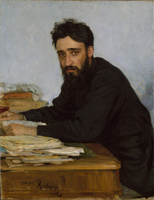
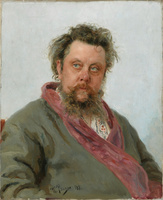
Leigh’s research is exemplary and her ability to relate works to their context is fascinating. Nevertheless, some analyses are speculative, given the limited amount of evidence provided by the author to support them. For example, some of the personal information that the author deduces from unfinished self-portraits of Bryullov and Ivanov seems frail, insofar as it is based only on visual analyses and equivocal letters. The same can be said of the author’s assertion that Kramskoi identified with the woman in his famous 1883 canvas Unknown Woman (fig. 5). The evidence—letters from Kramskoi revealing his alarming financial situation at the time—seems thin to make the argument truly compelling. However, this observation is also explained by the author’s difficult attempts to address a subject as intimate and unspoken as the feelings of men towards their own masculinity.
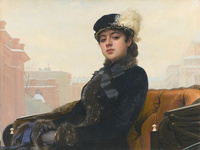
When turning the last page, it is obvious how successful Leigh’s enterprise of exploring the intimate feelings of painters is. It reveals a humanity and a vulnerability rarely seen in biographical approaches to the lives of artists. By highlighting aspects often disregarded in self-portraits and letters, Picturing Russia’s Men shows the indisputable importance of the question of masculinity in understanding these works and this turbulent historical period. Moreover, it seamlessly reminds the reader of the equally indisputable importance of the question of gender in understanding artists and their work in context.